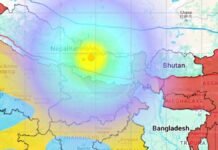
Patna: In a bold move, the Nitish Kumar-led government of Bihar has published the data of the caste census conducted in the state last year. The data reveals the population and economic status of various caste groups in Bihar, which is one of the most socially and politically diverse states in India. The release of the caste census data is likely to have a significant impact on the political scenario and the development policies in the state.
According to the data released by the Bihar government on Monday, the total population of the state is a little over 13.07 crore, of which 36 percent belong to the extremely backward classes (EBC), 27.13 percent to the other backward classes (OBC), 19.08 percent to the scheduled castes (SC) and 1.68 percent to the scheduled tribes (ST). The remaining 15.52 percent are classified as upper castes, which include Bhumihars (2.86 percent), Brahmins (3.66 percent), Kurmis (2.87 percent), Rajputs (3.45 percent) and others.
The data also shows that the Yadav community, which is included in the OBC category, is the largest caste group in the state with 14.27 percent of the total population. The Yadavs are considered to be politically influential and have been traditionally loyal to the Rashtriya Janata Dal (RJD) led by Lalu Prasad Yadav and his son Tejashwi Yadav. The second largest caste group is the Musahars, who are included in the SC category and constitute 3 percent of the population. The Musahars are one of the most marginalized and oppressed communities in Bihar and have been struggling for their basic rights and dignity.
The caste census data also provides information about the economic condition of each caste group based on various indicators such as income, landholding, education, occupation, health, sanitation, and social security. The data reveals that there are huge disparities and inequalities among different caste groups in terms of their access to resources and opportunities. For instance, while 44.8 percent of the upper castes own more than one acre of land, only 5.9 percent of the EBCs, 9.8 percent of the OBCs, 4.3 percent of the SCs, and 3.6 percent of the STs have such landholding. Similarly, while 71.4 percent of the upper castes have access to toilets, only 28.9 percent of the EBCs, 37.4 percent of the OBCs, 24.4 percent of the SCs, and 17.8 percent of the STs have such access.
The caste census was conducted by the Bihar government after the central government led by Prime Minister Narendra Modi refused to enumerate castes other than SCs and STs as part of the general census. The Bihar government decided to conduct its own caste census with its own resources and passed a unanimous resolution in the state legislature in support of this decision. The resolution was backed by all nine political parties represented in the Bihar assembly, including Nitish Kumar’s Janata Dal (United), Tejashwi Yadav’s RJD, Ram Vilas Paswan’s Lok Janshakti Party, Upendra Kushwaha’s Rashtriya Lok Samata Party, Jitan Ram Manjhi’s Hindustani Awam Morcha, Sharad Yadav’s Loktantrik Janata Dal, Congress, CPI and CPI(M).
The caste census was carried out between June and December last year by enumerators who visited each household and collected data through a questionnaire. The data was then compiled and verified by various agencies before being released by the Bihar government on Monday.

The release of the caste census data has been welcomed by Chief Minister Nitish Kumar, who said that it was a historic occasion and congratulated his team for completing this task. He said that he would soon call a meeting of all nine political parties to discuss the findings of the caste census and plan further action for the development and welfare of all sections of society.
However, some political analysts have also expressed caution over the possible implications of the caste census data for Bihar’s politics and society. They have warned that the data could be used by some parties to polarize voters along caste lines and create divisions among different communities. They have also urged that the data should be used for positive purposes such as ensuring social justice, reducing inequalities, and promoting harmony.



















































